
GLENN LONEY'S SHOW NOTES
By Glenn Loney, June 10, 2001
 |
| SUNRISE
IN MONUMENT VALLEY. Photo: ©Glenn Loney/2001. |

|
|
|
Caricature of Glenn Loney by Sam Norkin. |
|
[02] Off To Steinbeck Country & Ashland Shakespeare
[03] Triumph at the Met—American Ballet Theatre
[04] BAM Imports Handel's "Rodelinda" from Ireland
[05] Merrily Spinning "Carousel" at Paper Mill
[06] If You're in Town, See "Urinetown"
[07] "Forbidden Broadway" Lost in Space
[08] Unstoppable Playwrights
[09] Lives Stolen in "Thief River"
[10] Jazzy Memories in "Glimmer, Glimmer and Shine"
[11] Press the Button & "Eat the Runt"
[12] World Theatre Critics' Congress in Montreal
[13] Ariane Mnouchkine's " on the Dike"
[14] Of Toys Remembered in "Mémorie Vive"
[15] Stamping & "The Blue Duck"
[16] Robert Lepage: Deus Ex Machina?
[17] Belgian Family-Survival-Reality: "Allemaal Indiaan"
[18] "Catoblépas" & Two Mothers
How to contact Glenn Loney: Please email invitations and personal correspondences to Mr. Loney via Editor, New York Theatre Wire.
For archival versions of Glenn Loney's past columns, please try our internal search box or click here.
SHORT TAKES BETWEEN PLANES— To Write or Not To Write?
 |
| GLEN CANYON--Image & Reality in Northern Arizona. Photo: ©Glenn Loney/2001. |
There's so little writing-time between flights West, North, and East! Forget about anything like a detailed critique…
No sooner had I filed the previous installment of Show Notes than I flew off to Arizona for a week of therapeutic Jin Shin Jyutsu acupressure treatments.
This was linked with a whirlwind tour of Glen Canyon Dam, Lake Powell, Rainbow Bridge, Mexican Hat, & Monument Valley. Rainbow Bridge is the Largest Natural Bridge in the World. And it can be reached only by boat, secluded as it is among the flooded canyons of the lake. The photo-ops were terrific.
 |
| RAINBOW
BRIDGE--World's Largest Natural Bridge. Photo: ©Glenn Loney/2001. |
Incidentally, Lake Powell is not named for General Colin Powell, but for the intrepid one-armed explorer of this amazing geological area, Major John Wesley Powell—who lost his limb at Shiloh. Briefly back in New York City, I was able to sample the impressive repertory of the American Ballet Theatre at the Metropolitan Opera and catch up on post-award theatre openings.
 |
|
MEXICAN HAT--A
Stone Sombrero in the Navajo Nation. |
Then it was off again, this time to French Canada—to Montréal & Québec City—for the conference of the International Theatre Critics Association. This was fortunately programmed to coincide with Montréal's Ninth Annual Festival de Théâtre des Amériques.
But I did think seriously about not posting a Show Notes about all this, given the time-limits and the hordes of photo-prints & slides generated on the wing which needed to be immediately organized and indexed.
 |
PATTERNS OF MILLENNIA OF EROSION--Detail in Antelope Canyon, also called "Slot Canyon" or "The Crack." Photo: ©Glenn Loney/2001. |
Westward Ho! To Salinas & Ashland!
As I write this, I have just returned to New York for more catching-up, but tomorrow I am off to Steinbeck Country: Salinas & The Long Valley. I've been invited to "give a paper" on John Steinbeck at Austria's annual Bregenz Festival on Lake Constance.
On a specially designed & constructed lake-stage, in July Bregenz will premiere a two-summer-long spectacular production of Puccini's La Bohème. For the last two summers, an immense skeleton dominated the lake, the major visual element in Bregenz's epic staging of Verdi's Masked Ball. All the new visual & music-theatre surprises of the new production will be duly reported on this site.
 |
| TURN AROUND FOR SOUVENIRS--But you might want to watch your back anyway…Photo: ©Glenn Loney/2001. |
But on its handsome indoor stage, in the Bregenzer Festspielhaus, there will be an important new staging of Carlisle Floyd's opera, Of Mice and Men, based on John Steinbeck's Salinas Valley novel.
At the Bregenz Festival, the indoor productions are almost always of forgotten or neglected operas. These stagings—often shared with other major opera-houses in Europe—frequently give new life to these unjustly abandoned works.
In the case of Floyd's opera, however, it is simply not well known in Europe. Nor is it in any major or minor opera-house repertory. This forthcoming production may well be the introduction it needs to win a wider European public.
As a Nobel Prize Laureate, Steinbeck himself needs no introduction to European audiences. His novels—especially Of Mice and Men, The Grapes of Wrath, and East of Eden—remain both popular and beloved of continental reading audiences.
In fact, in Salinas, at the Steinbeck Museum—which just called to help set up my Salinas/Monterey/Carmel photo-safari—European Steinbeck fans often outnumber American visitors. As this coming year is Steinbeck's 100th Anniversary—with many special events and tours to Steinbeck Sites scheduled—there should be even more overseas visitors.
Incidentally, more copies of Steinbeck's novels are sold at the Salinas Steinbeck Museum each year than by Barnes & Noble and Amazon.com combined!
For Bregenz, I plan to photograph not only the museum & its exhibitions, but also houses and places where Steinbeck lived, learned, worked, and wrote, as well as sites of some of his novels, notably Of Mice and Men.
Dr. Alfred Wopmann, Director of the Bregenz Festival, invited me to do this—not only because I am that rare bird, a Native Son of the Golden West, born in Sacramento—but also because my mother's family settled in Salinas, after migrating from the East, in the late 19th century.
My Uncle Bob—who got rich from discovering precious wells of water under the parched Salinas Valley floor—delighted in bragging to Europeans when I was teaching there in the 1950s: "I gave John Steinbeck a bloody nose in the sixth grade!"
Others in the family were angry at being included in one or other of Steinbeck's novels. They thought knew who they were, even if the names had been changed. Actually, Steinbeck's characters were more often composites of closely observed people.
When I gave my mother a copy of East of Eden, however, she was delighted to find on the very first page the name of her dearest chum in the first grade!
When I took my Cousin Ruth to see the film of East of Eden in nearby Watsonville, where she had a lettuce-ranch, she hated it: "Adam Trask wasn't the first to send lettuce East in iced box-cars. We were!"
I was stationed at Fort Ord and thought this would be a real treat for her. She was contemptuous of James Dean's Caleb getting a loan from Will Hamilton to show his father what he could achieve: "Will Hamilton never had any money! He worked in a shoe-store!'
Sometimes Truth Is Not Stranger Than Fiction. In Steinbeck's case, he may just have found it to be more boring. Still, his interest in ordinary people—his affinity for their cares and dreams—is surely one of the magnets that still draws readers from many nations to his works.
When George Gershwin's folk-opera, Porgy & Bess, was given a fabulous two-summer-run on the great lake stage in Bregenz, I was invited, as now, to show my photos of historic sites in Old Charleston—including the original Catfish Row—associated with author Dubose Hayward and the novel, play, and opera.
These presentations are part of the annual summer Opera Workshop, in which teachers, students, opera buffs, and professionals are able to discover the backgrounds of the works being produced. As well as meet the artists, directors, designers, conductors, technicians, and others associated with the always impressive Bregenz stagings. We also get to watch rehearsals!
After snapping Steinbeck Sites in Salinas, Soledad, Pacific Grove, Monterey, Carmel, & Castroville—Artichoke Capital of the World!—I'll stop off at Stanford University to photograph Encina Hall, where he roomed.
Steinbeck never graduated from Stanford—where I got my PhD in Theatre—but we actually had some of the same professors. They were almost as young as he at that time. They were old and grimmer when I took their classes.
Oddly enough, Steinbeck & I also earned tuition money at similar jobs, although mine were in the Mother Lode Country. We both got poison-oak as rod & chainmen on Country Surveyors' crews. I also picked & packed pears, displacing migrant fruit-pickers & packers at even lower wages than theirs. This, even after I'd already read the book and seen the film of Grapes of Wrath. But I needed the money for school…
Immediately after photographing WPA murals of California Farm Workers in Coit Tower in San Francisco, I'm off to Ashland and the annual Oregon Shakespeare Festival. This will be the next report to be filed.
Then a Manhattan stop-over only long enough to repack for ten weeks in Europe at major festivals—with reports to follow in the fall…
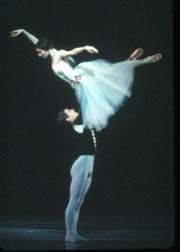 |
| ABT'S
"GISELLE"--Ashley Tuttle & Angel Corello as Giselle and
Albrecht. Photo: ©MIRA. |
A Triumph at the Met:
American Ballet Theatre's Summer Season—
It has been too long since I enjoyed
the excellences of the stars and company of the American Ballet Theatre.
Back in the days when I was a Contributing Editor for Dance Magazine,
I was a regular at the ABT, the NY City Ballet, as well as
at the seasons of many major & minor modern-dance companies. But, over the years,
the number of new theatre productions has so greatly increased, there's hardly
an evening free for opera or dance anymore. Forget about concerts…
The four productions I chose were all admired choreographies of famed fables. I simply did not have time to sample new choreographies. But I depend on former Dance colleague, NY Magazine's critic Tobi Tobias, for take-no-prisoners appraisals of works I've not been able to see myself.
Of the new ABT Pied Piper choreography & production-values, the only thing she'd like to save are the famous Hamlin Rodents! And they are puppets, rather than dancers.
Tobias has also expressed concern that the cavernous stage of the Metropolitan Opera is perhaps too vast for some of the ABT choreographies.
I didn't feel that was so much of a problem—even with only two principals on stage—when the dancing was superb and stars like Ethan Stiefel and Amanda McKerrow were at their brightest, as in Prokofiev's Cinderella, with Ben Stevenson's choreography. I'd last seen Stiefel in London at Covent Garden, but in Giselle. Promoted from Count to Prince, from London to Manhattan!
David Walker's settings for Cinderella did seem a bit strung out on the giant Met stage. And even the transition from the shabby vastness of Cinderella's father's manse to the princely palace was not all that impressive.
But then, the sets & costumes were borrowed from the Houston Ballet. What do they know about real palaces down there? Nonetheless, the costumes were splendid, even richly comic, as with the garish finery for the bumptious step-sisters, boisterously danced by Marcelo Gomes & Sean Stewart. Lady Bunny, look to your laurels & your falsies!
The secret to effective set & costume design—especially for classic program-ballets—is to be able to suggest place, time, & mood, either powerfully or subtly, without cluttering the dance-stage with set-props or constructing costumes which confine or inhibit the dancers.
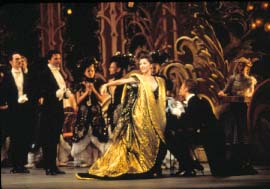 |
| HIGH
TIMES AT MAXIM'S--Ashley Tuttle as Valencienne in ABT's "The Merry
Widow." Photo: ©Paul Kolnik. |
My old friend & design-hero, Desmond Heeley, has achieved magic with his fabulously Neo-Baroque sets & costumes for Franz Lehár's The Merry Widow, with scenario & choreography by the late Robert Helpmann and Ronald Hynd. The effect was both stylish and sumptuous, splendid visual environments for the handsome & talented principals, Nina Ananiashivili & Guillaume Graffin, as Hanna & Danilo.
But what kind of theatre would The Merry Widow be without words & music—as in the operetta of the same name—or without music & choreography, as in the ballet? Probably not very interesting as a stage-play, unless audiences fascinated with Eurotrash Titles can be found.
There is a real problem with mime or acting in many ballets. As words cannot be used—except in the trendiest of modern works—dancers tend to use hands, arms, & facial grimaces to provide narrative detail which cannot be suggested merely by other body-movements.
This can be, nonetheless, very effective when dancers have been trained in expressive mime techniques. John Neumeier's Hamburg Ballet choreographies are notable for the way in which some almost undanceable ideas and observations are powerfully communicated through mime.
All too often, however—as in ABT's Cinderella and Merry Widow—comic moments and by-play are pantomimed or suggested with the broadest, even grossest, of gestures.
Almost a century ago, Konstantin Stanislavski tried to correct this, when he applied Moscow Art Theatre performance techniques to Russian opera & ballet productions. Over time, some outstanding choreographers of both classic & modern works have got his message. But not enough yet…
The ABT's Giselle production looks rather like the Royal Ballet's conventional Covent Garden vision, especially the cardboard-cutout village square. But I think Gianni Quaranta's ABT design for the haunted forest—where Giselle lies unquietly buried—is spookier. Irina Dvorovenko was an affecting and brilliant Giselle, well partnered by Maxim Belotserkovksy as the count who broke her heart.
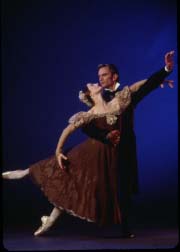 |
| TATIANA &
EUGEN ONEGIN--Susan Jaffe & Robert Hill in ABT's "Onegin"
ballet. Photo: ©Marty Sohl. |
Curiously, however, without the soaring arias, the score seems almost pallid when danced. This is certainly not the fault of such strong dancers as Giuseppe Picone as the egocentric Onegin, Angel Corella as Lenski—the dear friend he humiliates and then kills in a duel, or Irina Dvorovenko, as the spurned but loving Tatiana. Brian Reeder was also elegant & powerful as Prince Gremin.
Each of these four ballets had a different conductor: Ermanno Florio, Charles Barker, David LaMarche, & James Tuggle.
Musical Theatre Events:
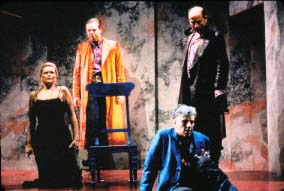 |
| HANDEL
IN IRELAND--"Rodelinda" at BAM. Photo: ©Kevin McFeely. |
Handelian Opera from Ireland—
With only a few evenings available between planes, the four music-theatre productions I was able to see are a very mixed-bag indeed. At BAM, there was Handel's Rodelinda, somewhat sparely re-imagined by the Opera Theatre Company of Ireland.It's been a long, long time since Ireland had a native opera composer of the renown of Michael Balfe. But no one is reviving his Bohemian Girl there, not even in Limerick.
Aside from the brief three autumnal weeks of the Wexford Opera Festival, Ireland, North or South, is not exactly a storm-center of opera production or innovation. Nor was the Rodelinda all that memorable, but at least Neil Irish brought Irishness to the design.
Helen Williams & Yvonne Howard were Rodelinda & Edwige respectively—and respectably. Others in the cast were Iain Paton, Jonathan Peter Kenny, Kirby Hutton, & Charles Johnston. James Conway staged, with Laurence Cummings conducting from the harpsichord.
It would be a real coup if BAM would import from Ireland instead one of the interesting, ingenious, & innovative Wexford Opera productions. But the Theatre Royal stage is tiny, the production-budget rather minimal, and the season strictly limited, so you won't be seeing a Wexford staging at BAM any time soon.
Certainly not in the BAM Opera House, where it would be lost on stage. Even the Harvey is too large for intimate music-theatre. Unless, of course, it could be staged on a carpet, Carmen-like, by Peter Brook!
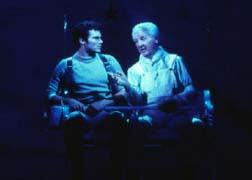 |
| PAPER
MILL "CAROUSEL"--Matt Bogart & Eddie Bracken, as the Starkeeper. Photo: ©Gerry Goodstein/2001. |
Carousel at the Paper Mill Playhouse—
Across the broad Hudson, over in New Jersey, popular revivals of Broadway Hit Musicals are Old News. Unlike the profitable novelty they've suddenly become in Manhattan.
At the Paper Mill Playhouse, the recent powerhouse production of Funny Girl has just been replaced with a budget-conscious but very handsome revival of Rodgers & Hammerstein's Carousel, brightly choreographed by Robert LaFosse.
Matt Bogart, as a swaggering Billy Bigelow, is almost prettier than his Julie Jordan, the lovely Glory Crampton. But they both sing and act with energy and conviction, making Ferenc Molnar's old fable of Liliom and his innocent young love fresh again.
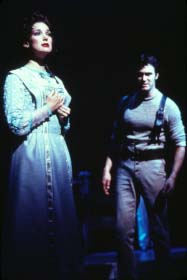 |
| IF
I LOVED YOU--Julie & Billy in "Carousel." Photo: ©Gerry Goodstein/2001. |
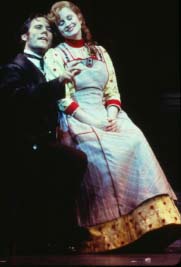 |
| WHEN I MARRY
MR. SNOW--Christiane Noll & Brandon Jovanovich in Paper Mill's "Carousel." Photo: ©Gerry Goodstein/2001. |
Christiane Noll was terrific as Carrie Pipperidge, and her Mr. Snow, Brandon Jovanovich, made her seem a much luckier girl than Julie. Until he got rich and stuffy, of course.
For the squadrons of silver-haired Seniors who throng Paper Mill productions, this show is indeed "full of a lot of real good songs!" This, or variations on it, was often heard in the lobby at intermission and on the way home.
For the older audience, however, the casting coup of this attractive Carousel was lowering from the flies none other than Eddie Bracken as the Starkeeper! He's not much of a singer—and he slushes his es's—but he's all Charm and Heart!
Pay To Pee!
If You're In Town, See Urinetown—
As soon as listings and ads for something
calling itself Urinetown the Musical began to appear,
I resolved not to make any effort to see it, let alone try to find out who the
press-agent might be.
As you may well imagine, the name really put me off. Which is what various members of the cast worry about in the actual show: "Who'd want to see a musical with a name like this?"
But the show's PR people tracked me down and urged me to go. And colleagues—who thought this show, in its own perverse way, to be as good as Batboy the Musical—insisted it was my duty to see it as an Outer Critics Circle Nominator.
The premise—if you've not already read about the production—should give our compassionately Conservative President Bush pause as he Deconstructs the Environment. Global Warming is parching the Earth. In Urinetown, there's so little water, taking a pee can cost you your Life's Savings.
John Cullum—the very opposite of his heroic persona in the musical Shenandoah—is the Oligarchic Monopolistic Capitalistic Meanie, Caldwell B. Cladwell, who has gained control of all the available water. As well as all the Public Toilets.
To say this show is "in the toilet" is more than a metaphor.
But it's a lot more than that. It is also an obvious parody of Bert Brecht/Kurt Weill 1920s Agit-Prop Music-Theatre works like Mahagonny & Threepenny Opera. This means it has a really jazzy period score.
It also owes a lot to Elmer Rice's Street Scene, to performance-techniques of the Group Theatre, and Social Protest productions of Theatre Union and other 1930s Socialist/Marxist Trouble-Makers like John Howard Lawson.
The admirable cast acts with the overheated passion of earnest Depression-driven under-employed actors. Almost every gesture is a Social Challenge—a Semaphore, a Call To Arms…
John Rando directed, with John Carrafa providing musical staging. Mark Hollmann [score] & Gregg Kotis [book] collaborated on the satiric lyrics.
An important extra production-dividend is staging this show in a shabby second-floor courtroom, next to a police station. It's like watching a Theatre for the Forgotten production for inmates at Riker's Island.
"Space Odyssey" Becomes "Spoof
Odyssey"—
Forbidden Broadway 2001 at Fairbanks Theatre
Gerard Alessandrini's hilarious Forbidden
Broadway has been good-naturedly mocking Mainstream Musicals for
18 years now. Long upstairs on West 72nd—now the Triad—it moved to Broadway
downstairs at the Starlite Diner. Narrow tables and Caesar Salad and a tasty
show on a narrow stage…
It may not have been a smart move to transfer to the larger stage and auditorium of the Douglas Fairbanks on Theatre Row. It has lost something of its intimate quality, with the audience pressing in on the stage.
In fact, on a recent Friday night, there weren't many in the audience. A limited turn-out is much more visible in a much larger auditorium.
Although the very talented and versatile cast performed with their usual sexy verve & wicked charm, some numbers didn't strike the sparks—or prove the laff-riots—they would in a much more cramped space, with laughing spectators packed close together.
Those who are Forbidden Broadway junkies cannot get enough of old routines. But I am a bit tired of seeing an ageing Annie—the Orphan One, not the Get Your Gun One—pining for a revival of that show with the Futuristic theme-song: "Tomorrow."
We are still seeing Ethel Merman & Julie Andrews. Alessandrini has to get some more wear out of the wigs & costumes of course.
But at least this Space-Cadet-Oriented Edition omits Carol Channing & Mary Martin. The latter is merely mentioned, but there are surely youngsters in these audiences who have never heard of either Martin or Channing.
All honors to Carter Calvert, Joel Carlton, Robert Gallagher, & Christine Pedi for their amazing abilities to mimic so many performers, song-stylings, mannerisms, and crochets!
The amazing foursome cannot possible recreate the hundred dancing feet of 42nd Street, but they do very well in keeping the show up-to-date with parodies of The Producers & The Music Man.
One way to salvage funny routines—and the wigs & costumes—based on long-running musicals recently closed is either to deplore or to celebrate their departure. This is done in style.
On balance, Alessandrini, the witty lyricist/parodist seems to believe that American Musicals will have a better chance when all the Brits have packed their bags & gone back home.
Even If There Were [not
was] a Law Against It—
They'd Still Be Writing & Producing Indifferent Plays
With all the various theatre-awards
already strewn over the variously worthy & semi-worthy, you might well wonder
why anyone would want to open a new show in late May or June. Even shows that
open in October are largely forgotten by March & April, when Awards Nominators
begin making their lists.
So I usually start jotting down potential nominees in early fall. The three new shows I've just seen won't make that list, I'm afraid. At least I was spared Blur and Nocturne, thanks to my tight schedule between planes.
The late-starter-trio I did see are Lee Blessing's Thief River, Warren Leight's Glimmer, Glimmer and Shine, and Avery Crozier's Eat the Runt.
Actually, each drama does have something to recommend it to undemanding & unsuspecting summer audiences. They are not merely masturbatory exercises in playwright-gratification. Although Runt is something of a manipulative jerk-off fantasy.
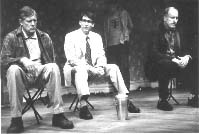 |
| DIGGING
UP THE PAST IN "THIEF RIVER." Photo: ©Susan Johann/2001. |
What Was Stolen in Thief River?
Lee Blessing already had a whole season to himself at Signature not so long ago. Having virtually run out of worthwhile & established Contemporary American Playwrights—who could sustain a season by themselves—Signature this past season returned to previous Scenes of the Crime with a grab-bag from Albee, Foote, Linney, & Blessing.Unfortunately, the intricate, intercut structure of Thief River undercuts the power & passion of its narrative.
Its action moves unnecessarily backward & forward in time, with six actors playing 12 roles. Each of the players portrays one of the two principals at one age or another.
Their virtuosity in instant & constant role-changes is impressive. Honors to Jeffrey Carlson, Erik Sorenson, Neil Maffin, Gregg Edelman, Frank Converse, and especially to Remak Ramsay. Mark Lamos staged.
But this is essentially an ingenious structural stunt which confuses the audience more than it dazzles. It also defuses much of the potential power of the story of the lost lives of two high-school chums whose love dare not speak its name in a small Midwestern homophobic town.
Caught in the act by a homicidal drifter, the boys are saved by the guardian of one of them—who makes them bury the bum after he's killed him. One boy leaves town. The guardian's ward stays, marries, raises a family, maintains his farm. But he never forgets his teenage passion.
In their seniority, his long-gone lover returns to deal with questions about the long vanished vagrant. Confrontation-Time! A linear narrative would have made this a much more effective drama.
It's not exactly The Laramie Project, but it's clear that Blessing is concerned about the virulence of homophobia, the prisons of small-town morality, and the need for tolerance, even acceptance, of alternative couplings & life-styles.
Someone ought to conduct an Opinion-Poll of long-married, family-oriented Senior Citizens—who are often the Subscriber Majority in many audiences for such Lesbian & Gay Consciousness-Raising dramas. What do they think? Aren't they getting a bit tired of this theme?
Especially if their Bibles and their Rabbis, Priests, & Pastors are telling them Homosexuality is a Sin and a Crime Against God!
More Jazzy Memories in Glimmer, Glimmer and Shine—
I'm no jazz-addict, but I did enjoy Warren Leight's semi-autobiographical Side-Man. Obviously, a lot of other people did as well, for it won a number of awards and has been widely produced.Glimmer, Glimmer and Shine returns to similar territory. Twin bothers were once very hot jazz trumpeters. One, zonking out on drugs, is saved by a very Determined Woman. He never touches his horn again. Or his abandoned brother.
His Jewish-Princess daughter from Greenwich [CT] meets a young musician in Manhattan. Although already engaged to another Greenwich Achiever, she's drawn to the unkempt, impoverished lad—who is obviously Out of Her Class.
By the end of Leight's drama, they have finally discovered who they really are—and how they are related to each other. And her dad tries a note or two on the new trumpet the princess has given him!
This is another one of those dramas in which the real action is all in the past, so the evening is spent recovering bits & pieces of it and fitting them together. It resembles Thief River in that regard, but with more justification.
Evan Yionoulis directed Scott Cohen, Brian Kerwin, Seana Kofoed, & John Spencer with an eye to maintaining maximum tension.
Eat the Runt at the American Place Theatre
As for Eat the Runt, it is essentially a gimmick-play, complete with some egregious technical gimmickry. Pressing numbered buttons on individual key-pads, audience-members get to choose seven of the eight cast-members for the various roles.The characters are given gender-ambiguous names so any role can be played by either a man or woman. This gender-switching doesn't always work smoothly, but it certainly provides the audience with some suggestive sexual titillations.
The drama's premise is that an Art Museum is having a Nationwide Search for a Fund-Raising Grant-Writer.
Why anyone would want this job—considering the odious personalities already employed by, or supporting, the Museum—is the real and unanswered Major Dramatic Question.
But this is the day that Merritt, a job-applicant from LA, is to be grilled by all levels of the Museum—except the janitor. The Runt of the title refers to the weak pup in a litter that a canine bitch is apt to eat. It is one of the gross-out comments Merritt makes in a concentrated effort to confound & confuse all who are conducting the interviews.
Very soon, there are two Merritts on hand, each insisting the other is an impostor. The eighth actor—not chosen in the audience polling—gets a role after all!
These are the Interviewees from Hell, wreaking moral & cultural havoc in the Art Museum from Hell. Mayor Rudy would surely close down not only the Museum, but also this production!
 |
| MONTREAL'S HANDSOME
CENTRE DES ARTS Photo: ©Glenn Loney/2001. |
Parlez-vous Français Québequoise?
20e Congrès de l'Association
internationale
des critiques de théâtre
au 9e Festival de Théâtre des Amériques
The theme of the recent 20th Congress
of the International Association of Theatre Critics was: Franchir
le mur des langues. Or: Breaking the Language Barrier.
Delegates from many lands gave papers, issued manifestoes, posed questions, & played Cultural Politics. Some of us who were non-delegates came primarily for new adventures in theatre at the Ninth Annual Festival of Theatre of the Americas—and for the various banquets & receptions in Montréal & Québec City. My playwright-friend & critic-colleague Mario Fratti & I were interviewed for Canadian TV: "Is Celebrity important for a theatre-critic?"
How would I know about that? Not having yet had my Fifteen Warholian Minutes of Fame…
For decades, I have avoided such meetings, conferences, & congresses, many of which take place in summer when I am always in Europe at the major music & theatre festivals.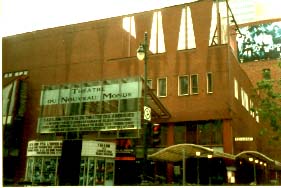 |
| POST-MODERNIST
PLAYHOUSE--A fitting home for Modernist Théâtre du Nouveau
Monde. Photo: ©Glenn Loney/2001. |
As I already was a tenured professor of theatre in the City University of New York, there was absolutely no need to network at an Educational Theatre Conference. Why would I ever want to leave the New York Theatre Scene, CUNY, or the Metropolitan Opera & Met Museum of Art?
For a $2,000 per year raise at Michigan State University? Get Real!
But this summer, for the first time, I realized the full importance of Cultural Networking. Our new International President is my old friend Ian Herbert, founder-editor of the invaluable London Theatre Record.
Down at the New York University Center for Advanced Technology, advanced computer-software technologists are even now preparing my thousands of previously published—and even more thousands of unpublished—chronological entries on British & American Theatre, from 1900 onward, for online research & information usage, complete with visuals, videos, and other Virtual Theatre Museum enhancements.But my own entries stopped at 1980, after which Facts on File published only two volumes of my chronology. The last two decades of London & British Theatre are missing.
Ian Herbert has already published all of this in London Theatre Record, but would like to make it all available online. Thanks to our talks in Montreal, it may now be possible to fill the gaps in my chronology and make Ian's copious data instantly available worldwide.
I have had a similar problem with entries on Canadian Theatre. Before 1960, there was not much of innovative importance happening in theatres across Canada.
But, with the founding of subsidized provincial theatres and the establishment of the National School of Theatre in Montreal, all that suddenly changed. Not to overlook the international importance of the Stratford Festival and the Shaw Festival in Niagara-on-the-Falls.
And who did I meet at the Congress who just happens to have all the facts about these developments in Canadian Theatre? Professor Don Rubin, of York University in Toronto!
Forty years ago, Don was an eager theatre-student at Hofstra University on Long Island. And I was a professor in that department. He'd very much like to get the Canadian Theatre Chronology online. And, obviously, so would I! So going off to the Montreal Congress may be one of the most serendipitous trips I've ever taken!
I was also delighted to meet again my old friend Prof. Kalina Stefanova, from Sofia, Bulgaria. She was elected Vice-President of our association.
When she was on a Fulbright Grant in New York some seasons ago, I introduced her to our leading drama critics for her research project on Broadway & Off-Broadway Theatre Criticism. Everyone spoke to her very frankly—not only because she is both beautiful and smart—but also because most thought their remarks would only be read in Cyrillic in the Balkans.
As things turned out, Kalina's Who Calls the Shots on the New York Stages? was published in London & New York by Harwood Academic Publishers. There were some red faces in Manhattan as a result, so British critics were much more guarded when Kalina interviewed them for Who Keeps the Score on London Stages?
She followed this with a very important study, Eastern Theatre After the Iron Curtain. With the fall of the Berlin Wall, many outstanding East European artists—especially those musicians, dancers, & singers for whom language was not a problem—left their home-theatres in the lurch for far more favorable opportunities in the West. And arts-subsidies were cut drastically, with many theatres closing or cutting-back in the past decade. This book should be much more widely known and studied.
I owe the publication by Harwood of my Peter Brook chronology—Peter Brook: From Oxford To Orghast To India—to Professor Stefanova's intervention. She also was instrumental in getting me to the Varna Festival of Authentic Theatre.
In Montreal, I was also able to meet very interesting critics from a number of countries. I was especially impressed by the delegates from Cuba & China—the two nations which Colin Powell & Dick Cheney have named as America's Only Remaining Enemies.
Get a Life, guys! Or something resembling an Enlightened Foreign Policy. Not to mention a Culture Policy…
In any case, I am certainly going to make a professional call on Dr. Minghou Liu when I am next in Shanghai! Could she be a distant relative of Emily Liu, the admired Taiwan actress who did her Master's Thesis with me at Brooklyn College?
My old friend, Sanja Nikcevic—former chief of the International Theatre Institute in Zagreb—also invited me to an important Croatian Theatre Festival. [Für Deutsch-Sprechender Fachleute, Zagreb ist noch als Alt-Habsburgische Agram bekannt.]
Alvina Ruprecht's report on the state of Canadian Theatre astounded me. In the early 1960s, when I had a car and free weekends, I used to drive up to Toronto and on to Montreal—where I had friends teaching at McGill University. There was very little theatre-activity in either Canadian city.
At that time, there wasn't much Francophone theatre in Quebec Province. And you could still hear a lot of English spoken on the streets of Montreal. Professors at McGill wore black academic gowns when they lectured!
Now it's against the law to have English signs on shops. And Quebequoises seem militant in their determination not to speak—or easily understand—English. Montreal has become more and more like Paris in that regard. But it also, like Paris, fortunately now has a vibrant theatre-life, with many theatre ensembles.
Nonetheless, our Montreal hosts, Louise Vigeant & Michel Vaïs, could not have been more genuinely friendly and constantly helpful.
The high point of the Festival was Ariane Mnouchkine's Tambours sur la digue, which I had already seen at the Théâtre du Soleil two seasons ago in the Cartoucherie near the Chateau of Vincennes, a suburb of Paris. I admired it then and now do so even more, although some of my colleagues were dismissive of the concept and of the production.
For the record, I'll recycle here my impressions of the show in Paris:
on the Dike
Mnouchkine at the Cartoucherie!
Paris loves innovative theatre directors.
Robert Wilson—who stood two feet away from me on the Metro
one evening—is a great favorite.
Some of Peter Brook's greatest theatre achievements have been developed in Paris, first at the Gobelins and currently at the Bouffes du Nord.
But surely the greatest favorite is the dynamic Ariane Mnouchkine. With her Théâtre du Soleil, a dedicated international collective of actors, she "occupied" a former Army Caserne where rifle ammunition was once made.
This is the Cartoucherie. One of its large halls currently contains two Mnouchkine theatre-spaces, with a large area between them for eating and schmoozing.
It is a feature of Mnouchkine theatre-adventures that there will be food—keyed to the production—for the audience before, during intermissions, and after the show. This is served by members of the ensemble.
It's often prepared by Mnouchkine, and she certainly helps tidy up afterward and even wash the dishes. You won't catch Peter Brook or Robert Wilson doing that!
For her new show, Tambours sur la Digue, egg-rolls and other items of Chinese cuisine are available in generous servings. Written by Hélène Cixous, the title can be translated as —or Drummers—on the Dike.
As Mnouchkine told our group of American theatre-critics—and an eager delegation of theatre-students from Amiens—the drama is based on an actual event in China.
Chinese authorities, building new great dams, have heedlessly flooded entire valleys and villages, with no regard for the people living there. But Nature herself can be devastating, as in a catastrophic 1998 flood.
In this piece, a peasant rallies friends to warn their people of an impending flood with frantic drumming on the dike. It recalls the deaf-mute Katrin's drumming in Bertolt Brecht's Mother Courage, also to save a town from destruction.
Immediately under the title on both programs and flyers, is this explanation: "In the form of an ancient play for marionettes, played by actors."
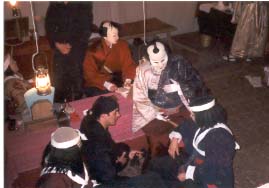 |
| HUMAN BUNRAKU
PUPPETS--Ariane Mnouchkine's actors prepare for Montreal performance of
" on the Dike." Photo: ©Glenn Loney/2001. |
The actors in the play are moved like life-sized puppets by "invisible" black-clad handlers. This creates an amazing resonance in performance, as the handlers respond to the emotions and actions of their respective "puppets."
Mnouchkine explained that she made no attempt to recreate Bunraku in every detail. That would have taken years, for the traditional training for a manipulator of a right-hand of a Bunraku puppet requires years.
The company did not begin with the idea of telling Cixous' affecting Chinese tale with Japanese techniques. That developed during rehearsals.
[Years ago, Michael Meschke, of the Stockholm Marionette Theatre, was the first in the West to adapt Bunraku techniques successfully. For a classic Greek tragedy, he reversed the color-code, cladding all the handlers in white, with the gods & humans in black.]
Much of the action of na takes place on a raised square, a section of the dike made of great wooden beams. It overlooks a symbolic river below.
Behind this, a series of filmy silky backcloths shimmer and drop out of sight, suggesting different times of day or changing weather and emotions.
The drumming itself—like the pounding Japanese Kodo which have become internationally known in concert—is all too brief. But it's dramatically effective.
The entire drama is greatly enhanced and nuanced by the music of Jean-Jacques Lemêtre, who wonderfully plays a wide variety of exotic instruments at the side of the raised stage.
At the unforgettable climax of the drama, the wooden platform on the top of the dike bulwark begins to sink under the rising waters of the flooding river.
As this stage disappears below the flood, the black-garbed puppet-handlers throw small puppets—representing all the characters the audience has just seen—into the turbulent waters to drown!
This is a striking visual effect, but it's obviously not ideal for touring. In fact, it seems permanently at home at the Cartoucherie.
Not so! Mnouchkine told me that it is promised for the Brooklyn Academy of Music, or BAM. Her Théâtre du Soleil had a great success there with Les Atrides, their version of the Oresteia.
That was performed in a large Armory—where her actors could also live adjacent to the stage, observed by the more curious in the audience.
She told our group that this Armory is no longer available, but on the Dike clearly needs such an open space. BAM's Majestic—now the Harvey Lichtenstein Theatre—has a proscenium-arch which could be unfriendly to the effect of this production.
At the Cartoucherie, the actors still have a special section for relaxing, costuming, and making-up. As they did in Brooklyn almost ten years ago.
But then they were supposedly living together as a collective in their theatre-space. I asked her how this communal life-style worked now.
Mnouchkine smiled and said that the ensemble did not now live at the Cartoucherie: "I assure you that they go home to their beds."
Another Dream of Collective Art & Living shattered!
The Théâtre du Soleil company is currently alternating another play by Hélène Cixous—Et soudain des nuits d'eveil—with on the Dike.]
Of a Girlhood's Toys Remembered—
In Montreal, I also liked very much Mémorie Vive, an enchanting fantasy of a little girl and her remembered toys from long ago. This unusual visual exploration included a toy train with a toaster and a hand-vacuum-cleaner as cars on stage-spanning toy tracks.A small video-camera on one train-car projected much larger images of the girl and the world of her toys on an upstage screen. The successively smaller false-proscenium framings of these stage-pictures were constantly quivering with rapidly moving projected patterns.
This is a fascinating dream-like experience in which language poses no problem. Produced by the Les Deux Mondes Théâtre, it seems ideal for such venues as the Edinburgh Fringe Festival, the Berlin Theatertreffen, or the Jim Henson end-of-summer Puppet Festival in Manhattan.
 |
| DEAD MAN PUPPETRY--Hanged
hero of "Anatole Feld" is manipulated like a marionette in Montreal
show. Photo: ©Maxime Côté/2001. |
Rubber-Stamping, Hanging, & The Blue Duck—
Both Anatole Felde & le Canard bleu—produced by la Compagnie à numero—have similar touring potential. Anyone who has ever worked in an office—or has had to deal with obtuse officialdoms—will understand why poor Anatole decides to hang himself from his overhead desk-lamp.That his colleagues then use his limp body like a giant puppet for grotesque Fun & Games is both bizarre & hilarious.
The sound-motif of both these short & office-related satires is a strange thump-thump-thumping—like the ponderous pounding of a great machine—before the curtain rises. When at last it opens, three men at three desks are resolutely and mechanistically stamping form after form.
In The Blue Duck—a literal, not idiomatic, translation—the lowest man in the office pecking-order suddenly seizes control, reducing his former boss to desperation and servitude.
 |
| QUÉBEC
FIREHOUSE BECOMES [DEUS] EX MACHINA--Theatre innovator Robert Lepage's
Landmarked Headquarters. Photo: ©Glenn Loney/2001. |
Québec's Deus ex Machina:
Robert Lepage Out of the Machine
In Québec City, the celebrated theatre-innovator
Robert Lepage was unfortunately not on hand when we visited
his Ex Machina workshop & theatre-studios. We did get the full
tour, however, and visited his arts-installation, Crossings Seen,
next door at the Museum of Civilization.
This oddity featured a Tower of Babel, an Interwoven Forest, Curiosity Cabinets, and an Anatomy Theatre. A silver-screen section informed us that the English language is half-French, thanks to the Norman Invasion of England in 1066.
Having studied the Growth & Development of the English Language, I must note that this is not really accurate, although French was the language of the Court and the Law in Medieval England.
 |
| DON JUAN'S COMING TO QUÉBEC--At the Théâtre Capitole Cabaret. Photo: ©Glenn Loney.2001. |
I recalled Lepage's technological disaster not so long ago at the Edinburgh Festival, when his opening-week premiere had to be canceled—with great loss of advance ticket-sales—because a broken screw in his Hamlet-oriented theatre-machine could not be replaced in time. Ex Machina had not brought along an extra screw.
Edinburgh Festival Director Brian McMaster suggested to me that Shakespeare should be self-sufficient, with or without screws or machines. But technical novelties are often what Lepage's works are largely about—rather than texts or passions.
TV Survival-Show Effects Onstage:
Belgians Try To Re-Invent the Wheel!
After admiring the Neo-Renaissance
Chateau Frontenac, our group wasn't quite prepared for the architectural and
dramatic banalities of the Belgian Allemaal Indiaan,
as staged & performed by Les Ballets C. de la B. et la Compagnie
Victoria of Ghent.
This was rather like that French TV domestic-survival series, Loft Story, in which voyeuristic audiences get to snoop into the minute-by-minute living of shameless couples, hoping to win a house.
Allemaal instead provides this experience live on-stage, with the often bizarre and then boring activities of two families in two neighboring white two-story houses. And they do behave like Wild Indians…
This touring Slice-of-Life show is a co-production with such festivals as those of Aarhus, Hannover, Holland, Hamburg, and Salzburg. The latter connection is worth noting for the retiring director of the Salzburg Festival, Belgium's Gerard Mortier, is slated to run Ghent's new Performing Arts Complex.
Way back in the Sexy Sixties, a Dutch Family settled into a SoHo loft, where you could pay admission to watch them carry on bodily & familial functions 24 hours a day. It was really rather boring, but it had been a big success back home in Amsterdam.
Allemaal Indiaan is a generic descendant of this earlier Reality Manifestation. It may seem like a daring innovation today, but only to younger audiences & critics. In each generation, it seems necessary to re-invent The Wheel.
But experience has shown that the Ideal Wheel should be round—not oval, square, or triangular…
I had already seen the New York City Players' production of House, to which I would not send my worst enemy. Nonetheless, some of my international colleagues were impressed with its avant-garde pretensions.
I deliberately avoided Rwanda 94, an almost six-hour-long recapping of the horrors of tribal slaughter in that doomed African nation. This theatrical epic, or ordeal, was the incantory work of Belgium's Groupov, under the rubric of Theatre of Truth.
Novel Sequel in Stage-Format: Catoblépas
Our theatre-adventures concluded with Catoblépas, a production of UBU, compagnie de création. This ensemble is no relation to New York's Ubu, now disbanding.It proved the rather non-dramatic sequel to a much-admired & best-selling French-Canadian novel by Gaétan Soucy. Director Denis Marleau prevailed on the author to pick up the story of that novel, La petite fille qui aimait trop les allumettes—twenty years later.
The two-hander was produced on a gently arched bridge—a kind of French-Canadian Hanamichi—stretching across the black-box of the Théâtre d'Aujourd'hui and dividing the two sections of audience. A nun—who had raised the son given up years ago by the mother now determined to find him—is confronted by that deeply needy woman. But their varied visions of the unseen son, Robert, tell more about their own projections of mother-love and hope than about him.
Unfortunately, the design-decision to confine the duologue to the narrow bridge reduced physical action to a series of steps and changes of position. The bridge—though it may be a visual metaphor between the two "mothers"—does nothing to heighten dramatic tension or clarify feelings or intentions.
My admired colleague, Kalina Stefanova, had earlier presented our Congress with a paper entitled: Emotions: The Esperanto of the Theatre. I certainly agree with her, for often I see—and really believe I understand much of—productions in languages unfamiliar to me. Thanks in large part to the emotive power and mimetic skills of the actors.
So I was rather amused, after we'd seen Catoblépas, to hear her say she didn't understand anything that happened on stage. She is a beginner in French. But Emotion did not help her—or me—in this production, as there was so little of it in the text or the performances.
But, thanks to our Congress—as well as to Louise Vigeant & Michel Vaïs—I have finally found my way back to Montréal and Québec. And to Francophone Theatre in North America!
As we strolled down a French-signed avenue—or rue, one of our American Delegation off-handedly remarked: "It's like being in a foreign country here." He wasn't joking.
Yes. Well, after all, Canada is actually a foreign country. And French-Canada is even more so!
But at least our common fascination with the World of Theatre links us not only Continentally—but also Globally.
[Loney]
Copyright © Glenn Loney 2001. No re-publication or broadcast use without proper credit of authorship. Suggested credit line: "Glenn Loney, New York Theatre Wire." Reproduction rights please contact: jslaff@nytheatre-wire.com.
| museums | recordings | coupons | publications |& classified |